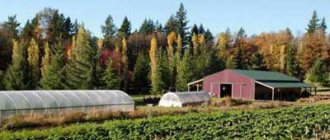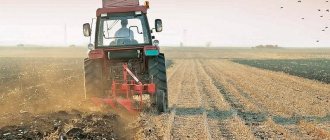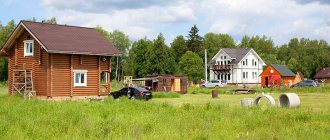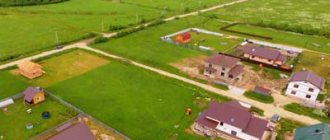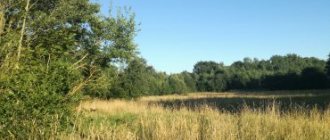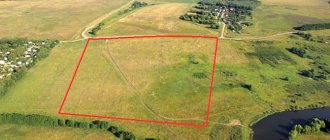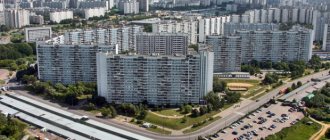Not all lands owned by the state can be used by legal entities or individuals in their own interests.
Most of the lands that can be seen around populated areas belong to a special category of resource called reserve lands.
However, these lands can also be used if the need arises. How exactly can this be accomplished?
Legislative acts
The procedure for disposing of, assigning categories and protecting reserve lands is prescribed in the legislation:
- Land Code;
- federal and regional regulations and laws.
In accordance with the regulatory framework, the use of plots of this type is strictly limited, transfer to private hands is impossible without assigning a category, and responsibility for their condition rests entirely with the entity on whose territory this plot is located.
Land protection measures
Protection of reserve areas is a set of actions aimed at preserving the quality of land, increasing their productivity and fertility. Measures to protect territories include:
- protection of land from erosion, flooding, swamping and other negative natural impacts;
- actions to preserve soils and their fertility;
- protection of farmland from overgrowing by weeds;
- elimination of the consequences of pollution, including man-made ones;
- development of legislative acts in the field of land protection.
For this purpose, federal, regional and local programs are being created, which include a list of mandatory measures to ensure the safety of sites, taking into account the characteristics of economic activity, natural and other conditions.
Assessment of the condition of the land and the effectiveness of conservation measures is carried out taking into account environmental assessment, sanitary, hygienic and other legislative requirements.
Detailed information is contained in “Legal protection of lands”.
What applies to reserve lands?
The list of territories not subject to transfer into private hands includes:
- located at a far distance from cities, villages, industries and agricultural lands;
- agricultural lands taken out of production due to depletion of their resources;
- reserved forest lands for the construction of industrial facilities;
- unusable reservoirs;
- forests that are currently unsuitable for use.
Land is the most important resource for the state, so it leaves part of the fund in reserve so that the development of space is not chaotic and unsupervised. The development of these territories is possible only in cases of extreme necessity.
The main problems of redistribution of plots
Russia occupies a huge area, and the management of such a large number of territories is accompanied by problems in the field of land redistribution. The main difficulties include:
- Bureaucratization and a long period of time for changing the category of territory. This leads to delays in land development and may even create obstacles to the implementation of national projects.
- Encumbrance of easements on areas for which a change in purpose is planned.
- Lack of properly completed land documentation or its loss.
- The inability to transfer a territory to another category due to its condition: pollution, erosion, and so on.
Legal status
In accordance with the Land Code of the Russian Federation, reserve lands are prohibited from:
- transfer into private hands, both as property and as a lease for any period (Article 96);
- use the fields, forests and reservoirs located on the territory for industrial, agricultural and other needs;
- take any actions to the detriment of the territory and objects located on it.
Legislation allows:
- use of lands by citizens for personal non-industrial purposes: picking berries, mushrooms, fishing, hunting;
- you can be free on the territory, it is not classified as closed;
- it is possible to drive livestock through the reserve lands;
- collection of dead wood for heating a personal home, without harming trees, etc.
In addition, Article 45 of the Land Code of the Russian Federation allows:
- carry out geodetic and cadastral work on the territory;
- examine the soil for minerals;
- conduct training and research work.
In some cases, it is possible to create personal farms of citizens on reserve lands with the permission of the body in whose department the territory is located. Conditions for provision (Article 60 of the Land Code of the Russian Federation):
- the citizen is not a member of the collective farm;
- he does not work in an agricultural enterprise;
- he plans to organize a farm for personal purposes.
Who is the owner?
Reference! The reserve land is not ownerless. It is owned by the state and, accordingly, it is under the jurisdiction of the regional centers of executive and administrative authorities.
The list of plots belonging to this category is recorded by the state land cadastre. At the same time, the legislation does not establish any restrictions on the number and size of plots provided from the category of reserve lands. Reserve lands are provided by regional entities for any of the purposes specified in the application on certain rights for permanent use or for lease for large enterprises.
Transfer to another category
Without assigning a category to a site, transfer to private hands on the basis of ownership or lease is impossible. Permission to develop land must be obtained; the violator faces administrative liability for unauthorized seizure of the territory.
The right to use the land is issued by the district administration responsible for the reserve land. When a plot has a specific purpose, it can only be used in accordance with cadastral information.
In what cases is it possible to change the category of reserve lands:
- a decision was made to create an object with a special status on the territory and make the territory closed: a national park, nature reserve, wildlife sanctuary, etc.;
- expansion of the boundaries of the municipality is required: increasing the territory of the city or village;
- it is necessary to build on the site an infrastructure facility for the life of citizens: a power plant, a water pumping station, power lines, roads, a water supply system, an oil pipeline, a medical or educational institution, etc.;
- At the expense of reserve lands, it is planned to strengthen state borders (the land is transferred for defense needs);
- It is planned to develop mineral deposits and extract them, for which it is necessary to build special facilities to facilitate this task.
Other purposes are not grounds for transferring reserve lands to any category.
But even if the goal is included in the listed points, the transfer may take a long time, and the initiator must collect all the justification for the procedure.
What rights are given to possession?
When transferring rights to use land, it is necessary to transfer the site from the list of reserve lands to another appropriate target category.
With the help of reserve lands, a land fund is also formed. Upon request, it must be provided for the resettlement of refugees and those migrants who were forced to leave their country.
In addition, plots for individual housing construction are allocated for permanent use for citizens who leave the Far North region (or other equivalent regions). In such cases, land is provided to citizens absolutely free of charge.
What is required for translation
Regardless of how the territory is planned to be used and what category it is transferred to, the algorithm will be the same:
- Drawing up a request for transfer. It should reflect:
- the initiator's plans for land development;
- arguments in support of the idea;
- cadastral number of the required plot;
- its dimensions;
- the current category (reserve land) and the one to which the site needs to be transferred.
- Preparation of a package of documents:
- for individuals – passport;
- for legal entities - information about the legal entity from the Unified State Register;
- expert opinion from the environmental commission on the possibility of exploiting the land in the planned way;
- conclusion of a cadastral engineer on land surveying;
- plan of buildings on the territory, detailed description of each object.
- Submit documents and petition to the department to which the allotment belongs:
- for federal lands - the Government of the Russian Federation;
- for regional ones – the executive body of the subject;
- for municipal – local government bodies.
Submission of documents is carried out in two copies, on one of them the receiving party puts down the incoming number and date. This mark guarantees that the application will be considered during a special inspection.
- Wait for the decision:
- positive - in the form of a Resolution on assigning a special category to land;
- negative – an act of refusal. It can be appealed in court.
Grounds for refusal may be:
- the applicant does not have the right to receive land for use or the right to file a petition;
- an incomplete package of documents prepared with errors or inaccurate information;
- the goal is not sufficiently reasoned, the applicant’s idea did not find support from the state;
- goals violate urban planning regulations: incorrectly chosen dimensions, development plans, lands are in a special status, etc.
Unused territories
Unused areas of reserve land are understood as territories that were not previously provided for the use of private individuals for lifelong ownership. This category of land is included in the list due to the lack of rights to the plots of individuals or legal entities. They belong to the land fund and may have appropriate natural and economic characteristics, according to which the owner will be able to determine their intended purpose in the future.
Why can't they be used?
Unused land plots are characterized as a special type of territory that is not used by agricultural enterprises and private owners due to its unsuitability for cultivation, sowing and construction. Reserve lands also include undeveloped areas that have lost any useful characteristics for a number of compelling reasons (radioactive conditions, increased noise levels, technological and natural disasters, low temperatures).
When is it allowed?
Such lands can be used only in case of emergency. In this case, the sites must be transferred to the target category. This is only possible in the following cases:
- The need to build civilian buildings with a “special” security regime (zones of nature reserves and natural parks).
- Changes to current regional boundaries.
- Conservation of areas due to their wear or loss of productivity.
- Development on the territory of mines and natural resources.
Note! The above list of reasons is the only good reason to change the target category.
Exception cases
The Government of the Russian Federation allows activities to be carried out on unused sites without the need to transfer them to the target category. The Government of the Russian Federation can use lands without assigning a category if:
- The land will not be classified as a closed protected area, and the natural resources available on it will be freely exploited by other people.
- Use of forest plots for fishing and hunting.
- Driving a herd of livestock to a further grazing area (without stopping).
- Collection of dead wood without preliminary work on cutting down forest plantations (dead wood can only be used for heating one’s own home and cannot be used to make a profit).
Time and cost of obtaining a category for reserve lands
The decision-making procedure is divided into two stages.
The first is checking documents for authenticity and compliance with reality. The authorities take 30 calendar days to do this. If violations are found, the applicant receives a certificate of refusal. Papers that pass the verification successfully are sent further.
The second stage is consideration of the application on its merits and the issuance of a decision. Deadlines – 2 months for municipal plots and lands of constituent entities, 3 months – for federal lands.
Submitting a package of documents is free. You will have to pay for the preparatory stage: land surveying, conclusion of the environmental commission and other items.
Possible difficulties
Problems often arise when land in use changes ownership. The application is submitted to the appropriate authority, where all attached documents and the application itself are checked. Acceptance of an application may be refused if:
- One or more required documents are missing.
- The document is not drawn up correctly and does not comply with the law.
- Documents are submitted by a person who does not have the appropriate rights. It is not uncommon for documents to be provided as proxies.
If there are grounds for refusal, a response is given within 30 days. Federal authorities make a decision within 3 months. Regional authorities are given a period of no more than 2 months.
When changing the category, the decision is issued in the form of an act. The act describes the size of the plot, cadastral number, address, assigned and initial categories.
A refusal may be obtained due to a restriction established by law, in case of violation of urban planning regulations and with the corresponding conclusion of an environmental assessment. The refusal can be appealed in court.
Agricultural land
Agriculture is the basis of existence of any society and state. All this forced legislators to allocate lands suitable for agricultural use into a separate category.
The category of agricultural land includes land plots located outside settlements, the economic function of which is to produce agricultural products. However, like the category of settlements, agricultural land includes a number of lands that have their own permitted use.
Within agricultural lands there may be the following types of permitted use:
- Areas occupied by roads along with rights-of-way;
- lands occupied by forest vegetation (forest belts serving the function of protecting fields, forest areas for other purposes);
- plots occupied by outbuildings;
- arable land;
- hayfields;
- pastures;
- gardens;
- fallow lands.
The fallow may be of a special use nature, for example, for the purpose of increasing soil fertility, or it may be forced when the owner or user for some reason stops cultivating the land in accordance with its permitted use. Typically, a deposit refers to the latter case. The deliberate transfer of land to fallow land is usually carried out when the economic and environmental value of the sites is lost due to natural and man-made disasters, long-term pollution, and soil erosion.
Subcategories of agricultural land
As the name suggests, agricultural work must be carried out on these lands, and the agricultural lands themselves must be located outside the settlements. The categorical division of land determines the purpose and content of use. For agricultural land, the legislator distinguishes two subcategories:
- agricultural;
- and non-agricultural land.
Despite the apparent opposition, both types of land are subordinated to the same goal - to provide conditions for agricultural production.
Agricultural grounds
These include land plots used only for the purposes of agriculture or livestock raising. In turn, agricultural land is divided into arable land, hayfields, pastures, fallow land (temporarily uncultivated land), and areas with perennial tree plantations. Moreover, this division is not arbitrary; all types of farmland have a special legal status that cannot be changed arbitrarily.
Areas that have undergone reclamation have a special status. This is due to the fact that in order for them to acquire the necessary resource properties, costly measures were taken to drain, water, restore soil fertility, and minimize erosion. Often such lands require uninterrupted reclamation work.
Non-agricultural land
Non-agricultural land is occupied by various auxiliary structures. These may include: roads, communications, protective forest belts, reservoirs, buildings that support agricultural production.
This non-agricultural status is subject to urban planning regulations, while agricultural land is not subject to its regulations.
Differences between the first and second
It should be noted that there is a difference between agricultural lands and residential areas where farming is permitted. In the first case, the land is a category and has a designated purpose, in the second, it is located within the boundaries of a populated area and has a specific permitted use.
Agricultural land is heterogeneous and has its own divisions based on the cadastral value principle:
- Land with low and medium value. These usually include lands of long-term fallow, areas of low fertility, subject to erosion, pollution, etc.;
- Land with a cadastral value significantly higher (50% or more) than the average for a given territorial unit;
- Land of special value. Their cadastral value far exceeds average values. Typically these include arable lands that have long been involved in agricultural production and have high fertility.
Grounds for refusal
A negative answer may be received in the following situations:
- When the applicant is not the proper person to make such a request.
- If the submitted package of documents does not meet the requirements established by law.
Reserve lands represent a special object in the field of land legal relations, since until their purpose is changed they cannot be used, nor can they be transferred into personal ownership of interested parties. But, in situations where the transfer is completed, the territory can be exploited in accordance with its purpose.
What to do if the category of land or VRI in Rosreestr differs from the data in the PZZ
What if there is different information on the same land plot? For example:
- In Rosreestr it is written on the land plot: Land category: Agricultural land Permitted use: For citizens to carry out gardening and vegetable gardening according to the document: for summer cottage construction with the right to erect a residential building with the right to register residence in it.
- At the same time, the PZZ says: CX-3 - Agricultural production zone. The PZZ is attached to the officially signed Resolution of the Administration of the Ramensky City District of the Moscow Region.
Based on general practice, we use the information contained in the Unified State Register of Real Estate. If the document indicates that the land plot is intended for gardening with the right to build a residential building, then we focus on this information. If reasonable questions or reasonable doubts arise regarding such data as the intended purpose, type of permitted use, location of the site in a particular urban planning zone, you have every right to make a simple written appeal to Rosreestr and the administration of your municipality.
I repeat, as a practitioner, I always rely on information received from the Unified State Register of Real Estate. However, it should also be noted that along with such information, the information contained therein may be unreliable due to any technical problems.
Lands of settlements
This is a category of land allocated specifically for compact living of people and placement of infrastructure facilities. Settlement lands have a clear boundary separating them from lands of other categories.
Within the category of land in settlements, the following types of permitted use are distinguished:
- Placement of multi-storey residential buildings. Objects can be located chaotically, forming streets, or in territorial blocks, forming microdistricts;
- Land allocated for individual housing construction (individual housing construction, individual railway);
- Recreational areas. They can be located both inside the settlement itself and in the suburban area. In accordance with Art. 98 of the Land Code of the Russian Federation, recreational lands include lands intended and used for organizing recreation, tourism, physical education, recreational and sports activities of citizens. Clause 2 Art. 98 of the Land Code of the Russian Federation establishes the composition of lands for recreational purposes, which includes land plots on which there are holiday homes, boarding houses, campsites, physical culture and sports facilities, tourist centers, stationary and tent tourist and health camps, children's tourist stations, tourist parks, educational hiking trails, highways, children's and sports camps, and other similar facilities. Clause 5 Art. 98 of the Land Code of the Russian Federation prohibits activities that do not correspond to the intended purpose of such a law. Recreational lands are intended for the recreational functions of both citizens and the preservation of natural properties; you can build on them, but only what is specified in Art. 98 Land Code of the Russian Federation. In addition, Art. Art. 285 - 286 of the Civil Code of the Russian Federation provides for liability for improper use of a land plot. In the event that the use of a plot is carried out in gross violation of the rules for the rational use of land established by land legislation, in particular if the plot is not used in accordance with its intended purpose, this land plot may be seized from the owner;
- Areas built up with industrial facilities, administrative buildings, public utilities, food and non-food supply facilities, etc.;
- Land allocated for transport hubs - train stations, airports, river and sea terminals, etc.;
- Location of power supply facilities;
- Lands that are part of a populated area, but occupied by bodies of water;
- Areas allocated for the placement of roads, canals, piers, pipelines, air, ground and underground communication facilities, etc.;
- Specially protected natural areas within the boundaries of a populated area. Typically these include: parks, natural monuments, nature reserves, objects of special cultural and historical value, botanical and zoological gardens, open-air museums, etc.;
- Land intended for agricultural use. Despite the consonance with the name of one of the categories, these lands are still within the intended purpose of settlement lands. These include personal subsidiary plots (PHS);
- All other lands that can be represented by the space of streets, squares, reserve areas, special objects that are out of circulation, rights-of-way, security zones, etc.;
- Settlement development reserve zones.
Do not confuse permitted use with land ownership. Objects that are federally owned, privately owned, owned by a municipality, or a subject of the federation can be located on the lands of settlements.
I am ready to advise you free of charge by phone (24 hours a day, 7 days a week)
The call is free for all regions of the Russian Federation
In addition, the placement of individual buildings should not be confused with settlements. For example, a forester's house, an apiary, industrial and residential premises at mining enterprises cannot be part of a populated area until the land under them changes its category.
What is the type of permitted land use (URL)
The concept of permitted use of a land plot is of a clarifying nature within the framework of the intended purpose. The introduction of this concept is a consequence of more detailed zoning of the territory on the scale of a federal subject, region or other territorial division. However, a land plot owned by a farmer may have a different permitted use within the same intended purpose.
In addition, there is a division of the permitted use into the following types:
- basic;
- conditionally permitted;
- auxiliary.
Table of the main types of permitted use of land
| Number in the classifier | Comments |
| 1.0-1.18 | This includes lands located outside populated areas that are intended for growing crops, livestock, fur-bearing animals, breeding birds, fish, and insects. It is allowed to erect buildings necessary for agricultural needs. |
| 2.0-2.7.1 | On these lands, it is possible to erect buildings, both single-story and multi-story, which are used for living, as well as the infrastructure necessary for their maintenance. |
| 3.0-3.10.2 | On the lands you can place capital construction projects that are necessary to meet social and spiritual needs - utility companies, healthcare facilities, schools, preschool educational institutions, etc. |
| 4.0-4.10 | The lands are intended for capital construction projects that are used for profit. |
| 5.0-5.5 | The plots are allocated for the placement of sports, tourist facilities, recreation centers, horse riding, etc. |
| 6.0-6.11 | Mining and production facilities are allowed to be located on the lands. |
| 7.0-7.5 | Various communication routes and buildings necessary to service them are placed on the sites. |
| 8.0-8.4 | They house facilities intended for the Armed Forces, as well as customs offices. |
| 9.0-9.3 | Lands on which specially protected natural areas are located. |
| 10.0-10.4 | Activities related to cultivation, logging, logging, and forest protection are permitted. |
| 11.0-11.3 | Water bodies and hydraulic structures are located on the lands. |
| 12.0-12.3 | The areas contain roads, cemeteries, parks, public gardens, etc. This also includes reserve lands. |
| 13.1 | Activities related to the cultivation of agricultural crops for one’s own needs are permitted. Residential buildings cannot be built. You can build outbuildings to store crops and equipment. |
| 13.2 | Activities related to the cultivation of fruit trees and shrubs for one's own needs are permitted. You can build residential buildings, garden houses (not for permanent residence), garages, and outbuildings. |
| 13.3 | The line has lost force since January 1, 2021 - Order of the Ministry of Economic Development of Russia dated August 9, 2021 N 418 |
Conditionally permitted type of land use
The conditionally permitted type of use of the land plot serves as a supplement within the category and permitted use. This addition occurs when it is not possible to create a classifier for all occasions.
In order to establish an additional standard, it is necessary to go through a special procedure for approvals and public hearings at the Land Use and Development Commission. Such an expansion of the VRI is possible only if it is provided for by local urban planning regulations.
Auxiliary permitted uses
Ancillary types of permitted use specify the actions performed within the framework of other types of use. A clarifying nature may consist, for example, in the placement of some small objects - garages, transformer booths, fences, etc. Thus, a potential developer needs to fit into the intended purpose and main type of permitted use of its territory.
Other types of permitted use can be changed in the official dialogue between the potential and existing owner of the site with state or municipal authorities.
For example, a land plot for building a house must have a category (intended purpose) - land of settlements, and the type of permitted use (AUR) - for individual residential construction (IHC).
The full list of VRI is exhaustive, is contained in a special classifier and is not subject to change in any order. If a new VRI is installed for a given territory, then it must correspond to the list of this classifier.
conclusions
From the perspective of building a house, it is advisable to use the following types of permitted use:
- For the construction of an individual residential building (IZHS);
- For the purpose of maintaining personal subsidiary plots (LPH);
- For running a dacha-type household and building a garden house, which is recognized as residential under the dacha amnesty;
- For agricultural production and peasant farms (peasant farms).
How to change the type of permitted use of a land plot
What is land zoning
